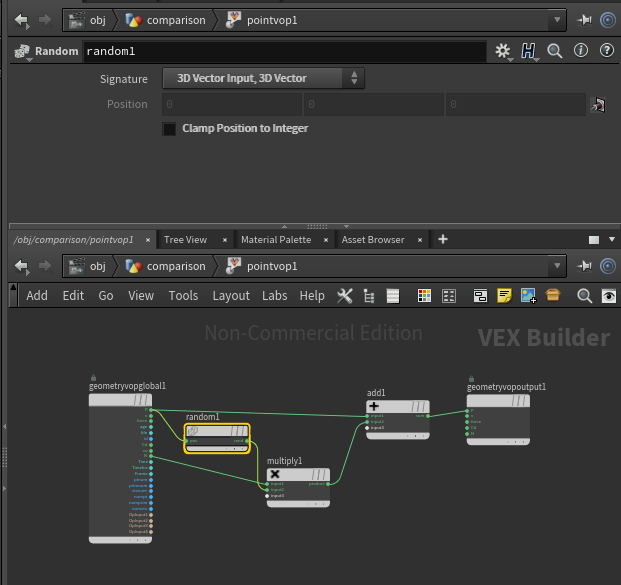Deborah R. Fowler
VEX/VOPS and a little Python
For more information on Python in Houdini
click here.
Updated on Jan 30 2014
Updated on Jan 15 2024
Also take a look at
this description on odforce between hscript, vex/vops and python.
Introduction
VOPS is Houdini's visual
interface to VEX. Vex stands for Vector expression language.
Both are native to Houdini. Introduced for writing shaders,
expanded to SOPS, wranglers added ability to use VEX everywhere.
VEX is becoming more popular
with the introduction of wrangle
nodes and VEX snippets. (use for writing shaders
and custom nodes). For examples of wrangle nodes, see page on wrangle nodes.
Both VEX and python code are
easily integrated by using their corresponding nodes, however
you may also use a digital asset as described below. This is
handy for production sharing.
VEX looks similar to old rsl
and C in terms of syntax. VEX is also very efficient (close to
compiled C++ code). VOP is a pictoral representation of VEX
code. Both can be used to create sops and are used in other
contexts (dops, pops, shops). As of version 14 and up, vops are
contextual (ie. point vop - (about 10x faster than the
point SOP), attribute, primitive, vertex, volume VOPS).
To create the containers to place the
code/nodes into:
- point VOP - create a node in the tab menu, for example Point VOP, dive in to play
- wrangle nodes (using VEX snippets)
- VEX requires an otl (digital asset) to store the code. The method to create a VEX sop was analogous to creating a python sop which is described here or in the example below, however in Houdini 16, there is one more step. The Geometry Operator is deprecated in favor of cvex, so if you want to use this method:
- create a vfl file with sop yoursopname() {} and then run vcc -l yoursopname.hda yoursopname.vfl
- Or use the preferred wrangle nodes as
described above
TIP: on wrangle nodes, use
the examples on the side (down pointing triangle) for quick syntax
help
python nodes can be created as described
above, or simply through the tab menu.
(Alternatively you could also create a vfl file with VEX code
and compile it using vcc to create an otl/hda). In H16 this is
the only way to get a new geometry operator. See forum
post https://www.sidefx.com/forum/topic/50606/
Once you have the otl created you can select
the operator from your Digital Asset menu in the appropriate
context and continue to refine your otl using the Edit VEX
Function button on your node or use Type Properties
and going to the Code tab.
Resources
- SideFX documentation on VEX, VEX language reference, VEX functions (built-in), and Using VEX expressions (snippets)
- VEX compiler pragmas (for building UI in your nodes)
- Wagner's Webinars: Houdini VEX
- cgWiki on Houdini Vex
- cgWiki
The Joy of Vex
Example
An example of moving a point along a normal is given in the following sample files (zip files that contains the hda for the VEX python version - be sure to refresh your digital asset library). Updated for version 16.5Note that when you are using random you need to specify if it is 3D or 1D (if you see dotted lines on the connection it indicates a mismatch of variable type)
So in the example of moving a point along a normal, be sure to set the random function to vector output

version 14 version 13.)
Lecture PDF for moving a point along a normal (updated for version 16) here.
For examples of vex snippets click here.
Example of zscale
Comparision of vex and vops noise - keep in mind you can visualize the code by right clicking on a VOP node and you can use the VOP functions inside of VEX by including the line
#include <voplib.h>
An example is shown in this hip file between noise in wrangles (primitive) and a vop
vopsVersusVexNoise19.5.hipnc
A note about VEXpressions (click on image for sample file H18.0.499)